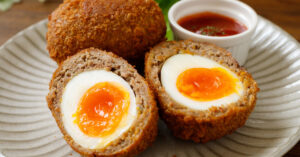No holiday is complete without these tempting Linzer cookies!
Sweet, buttery, and loaded with sticky jam, this traditional Austrian treat really is something to be celebrated.

Like raindrops on roses or kitten whiskers, Linzer cookies are some of my favorite things.
And what’s not to love?
These classic cut-out cookies are rich, perfectly crunchy, and delicately spiced. Plus, they come with the most deliciously fruity filling.
What Are Linzer Cookies?
Even if you’ve never heard the name Linzer before, you’ve probably seen Linzer cookies.
Heck, if you’ve ever been to the Midwest around the holidays, you’ve probably eaten them.
Or perhaps you’ve been to a Christmas market in Austria or Germany?
I guarantee you’ll have seen Linzer cookies there. Because these delicious little treats come from Austria.
They’re a jam-filled, almond shortbread sandwich cookie with a fun-shaped cutout in the center.
You often see them with a heart or star cutout. But any shape will do!
They have a nutty, buttery crust, and they are scrumptious.
And they have a long history.
Linzer Cookies History
Back in the 1600s, the recipe was discovered in the cookbook of an Austrian countess.
The original recipe was for a pie-like tart – kind of like a galette or crostata recipe.
It was made with an almond crust and filled with jam.
Then in the city of Linz, Austria, the cookies as we know them were created.
Bakers took the pie dough and cut it into fun shapes. Half of the dough would also get a center cutout.
After baking, the whole cookies were slathered in jam.
Then, a cutout cookie was placed on top. And that is how the Linzer cookie came to be.
Pretty cool, huh?

Ingredients
- Almond Flour- It imparts a delicate almond flavor and makes the texture of the cookie amazing. It will literally melt in your mouth.
- All-Purpose Flour- All-purpose flour provides extra structure. So the cookies aren’t too crumbly.
- Spices and Extracts- This recipe uses ground cinnamon and cloves to delicately spice the dough. And vanilla extract adds a lovely deep flavor.
- Salt- Salt adds balance to every dessert. These cookies are no exception. Plus, salt makes all of the flavors taste stronger.
- Egg– Eggs bind the dough, provide structure and leavening, add moisture, and enrich the dough.
- Butter– Because you can’t have a buttery cookie without butter. Butter is a necessary fat that adds flavor, moisture, and structure to the dough.
- Sugars– You’ll use granulated (white) sugar in the dough for sweetness, moisture, and structure. And you’ll use powdered sugar to garnish the cookie.
- Jam– It’s not a Linzer cookie without jam. The original recipe used blackcurrant, but we’re going with raspberry jam. I think it looks extra festive, but use whatever you you prefer.
How To Make Linzer Cookies
1. Make the dough. Some Linzer recipes use a traditional shortcrust dough. This one does not, so prepare the dough as directed.
2. Roll out the dough. Shape the dough into two disks and place them between sheets of parchment paper. Roll each disk until it’s 1/8 inch thick all around.
3. Chill the dough. Put the rolled-out dough onto a baking sheet or cutting board. Chill for at least two hours.
4. Cut out the bottom cookies. Cut whole cookie rounds out of one slab of dough and transfer them to a baking sheet.
5. Cut out the top cookies. Using the same cutter as above, cut whole cookies out of the second slab. Then, using a smaller cookie cutter (about 3/4 to 1-inch), cut out the centers to create a window. Transfer the window cookies to a baking sheet.*
6. Bake. Bake for about 7-9 minutes until lightly golden. Pay close attention, so they don’t burn.
7. Assemble the cookies. Slather the whole base cookies with jam and place the window cookie on top. Dust with powdered sugar, and enjoy!
*Bake the small cut-outs on a separate tray for 5-7 minutes and enjoy as minis.

Tips for the Best Linzer Cookies
Once you try these cookies, I know you’ll fall in love.
That said, I want your cookies to be the best they can be! So, I have a few tips to make sure they’re 100% scrumptious:
- The thinner the cookie, the better. Rolling the dough to 1/8 inch thickness is recommended. Otherwise, the cookie-to-jam ratio will be out of balance.
- Keep the dough cold. If you’re making multiple batches, roll out a chunk, but keep the rest in the fridge.
- Chill the dough before baking. This keeps the butter cold and keeps the cookies from spreading too much in the oven.
- Roll the dough between sheets of parchment paper. It’s much easier and makes clean-up a breeze.
Recipe Variations
Linzer cookies are completely customizable! After all, we’re already using a different type of jam than the OG recipe.
So, here are a few fun ways to make these holiday cookies extra special:
- Use fun cookie cutters. Hearts, stars, snowflakes, trees – whatever you have on hand will work just fine.
- Try a different filling. Apricot, blackberry, and strawberry jams are all fantastic options. Orange marmalade is also delicious!
- Try fruit curds or chocolate. I love these with passion fruit curd, ganache, or Nutella. Yum!
- Make them chocolate. Replace 2 tablespoons of all-purpose flour with 4 tablespoons of cocoa powder in the dough.
- Use almond extract in the dough. It makes the cookies super almondy and delicious.
- Add tea leaves! Yep, instead of the spices, add tea leaves. Earl Grey is a perfect choice. But matcha is also delicious.

How to Store Linzer Cookies
To Store
Store Linzer cookies in an airtight container at room temperature.
They’ll last for 3 days. You can store them in the fridge and they keep a little longer.
They may lose some of their crispiness, though.
To Freeze
You can freeze both the dough and the completed cookies.
Cookie Dough- Wrap the dough disks in plastic wrap. Put the wrapped disks into a freezer bag. Don’t forget to label and date them!
You can do the same with the rolled-out dough. Keep it in the parchment and then wrap it.
The dough will keep for up to 3 months. Thaw the dough on the counter overnight.
Baked Cookies- Wrap each individual cookie in plastic wrap. Then, add all of them to a freezer bag with a label and the date. Freeze them for up to 3 months.
Unwrap the cookies to thaw. They’ll be ready in about 1 hour.
More Cookie Recipes You’ll Love
Applesauce Cookies
Ginger Cookies
Rice Krispie Cookies
Swedish Butter Cookies












I had fun making these and figured out a few things along the way. You could edit the recipe and say when to cut the decorative heart or design of the top cookie. I don’t think that is mentioned. Next time I would spread the jam over the base cookie so they would stick together a bit better when complete, then fill in additional jelly in the recess. I love your breakdown of what the ingredients do. Awesome!
Hi Kathleen!
So happy you liked the cookies!
The method for cutting the holes and spreading the jam over the base cookies is in the post, but I’ve amended that section to make it more clear.
But you’re right, it’s missing from the recipe card. Thanks for catching that 🙂 I’ve added it
What is the difference between using only a yolk and using a whole egg?……….ingo.
Hi Ingo!
Great question 🙂
The difference between using only an egg yolk and using a whole egg lies in the texture, structure, and richness of the final cookies.
Yolk-only cookies are usually softer, richer, and more tender because the yolk adds fat without the structure-building protein from the egg white.
The extra fat enhances richness and creates a melt-in-your-mouth quality.
In contrast, whole eggs provide more structure due to the protein in the whites, which can make cookies firmer and slightly cakier.
So, if you want soft, rich, and slightly denser cookies, use only a yolk.
For firmer, chewier, or cakier cookies, go with the whole egg.
If a recipe calls for 1 whole egg, you can substitute it with 2 egg yolks.
Hope this helps!
Thank you. A clear comprehensive explanation.
Two questions:
I note you call for saltless butter, yet add salt.
Is there a chemical function (other than taste) for salt in baking?
Hi again Ingo!
To be honest, I almost always bake with salted butter and I’ve been a pastry chef for over ten years.
But the reason we typically say to use unsalted and then add salt is to control the amount in the recipe.
That’s especially important when creating recipes for the public.
Many people find using salted butter too much, as brands vary on the amount per block. So, some are more salty than others.
Essentially, it’s a safe way to ensure everyone gets the same finished result.
That said, salt does play a vital role in baking beyond just flavor:
Enhances Flavor: Salt balances sweetness and enhances the natural flavors of other ingredients, making baked goods taste more complex and delicious.
Strengthens Structure: In yeast-based recipes, salt helps strengthen gluten, giving bread and pastries a better structure and chewy texture.
Regulates Yeast: Salt controls yeast activity, preventing dough from over-rising and improving the final texture and flavor of bread.
Improves Texture: In cookies and cakes, salt helps balance the tenderness by interacting with proteins and fats.
Boosts Browning: Salt can contribute to browning in some recipes, enhancing the appearance of baked goods.
All that to say, if you want to use salted butter and omit the extra salt, go for it! That’s what I do 🙂
Thank you.
One more query…and that’s it.
Stir the jam every 10 seconds while heating for 30?
I presume the jam is watered to be diluted for spreading.
Thanks again…………..ingo